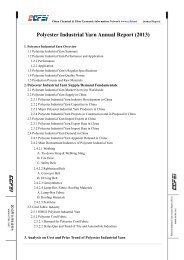Tasks and Feedstock Demand Changes of China Textile Industry ...
Tasks and Feedstock Demand Changes of China Textile Industry ...
Tasks and Feedstock Demand Changes of China Textile Industry ...
- No tags were found...
You also want an ePaper? Increase the reach of your titles
YUMPU automatically turns print PDFs into web optimized ePapers that Google loves.
<strong>Tasks</strong> <strong>and</strong> <strong>Feedstock</strong>Dem<strong>and</strong> <strong>Changes</strong> <strong>of</strong> <strong>China</strong><strong>Textile</strong> <strong>Industry</strong> during the12th Five-Year Plan PeriodXu KunyuanVice Chairman<strong>China</strong> National <strong>Textile</strong> <strong>and</strong> Apparel Council
<strong>China</strong> International Sulphur&Sulphuric Acid Conference(2011)Major <strong>Tasks</strong> for <strong>China</strong> <strong>Textile</strong> <strong>Industry</strong> during the12th Five-year Plan Period4To ensure sustainable development〈1〉To develop low-carbon, clean <strong>and</strong> recycling economyTo promote energy-saving, cost-efficient <strong>and</strong> low-emissiontechnologies <strong>and</strong> meet the targets set by state: EC/GDP downby 16%, CO2 per unit <strong>of</strong> GDP down by17%, unit waterconsumption <strong>of</strong> industrial added value down by 30%, <strong>and</strong>COD emission down by 8%.Proportion <strong>of</strong> recycled fibers in total fibers processed up to15% by 2015 compared with 2010’s slightly below 10%.To utilize the market mechanism to progressively wash outoutdated processes, technologies <strong>and</strong> machineriesMajor <strong>Tasks</strong> for <strong>China</strong> <strong>Textile</strong> <strong>Industry</strong> during the12th Five-year Plan Period4To ensure sustainable development〈2〉To develop proprietary br<strong>and</strong>sTo concentrate in improving product quality <strong>and</strong> R&D,marketing development <strong>and</strong> innovation. We target at 5-10proprietary br<strong>and</strong>s with worldwide reputation, 100 leadingenterprises with owned br<strong>and</strong>s, <strong>and</strong> 25% proportion <strong>of</strong> theproducts exported from proprietary br<strong>and</strong>s.〈3〉To intensifying efforts in human resourcesTo improve HR training <strong>and</strong> managing system, <strong>and</strong> make it apriority to train high-level, innovational <strong>and</strong> specializedpersonals.7
<strong>China</strong> International Sulphur&Sulphuric Acid Conference(2011)<strong>Textile</strong> <strong>Feedstock</strong> Structure during the 11 thFive-year Plan PeriodDuring the 11th Five-year Plan period, <strong>China</strong> textile industryachieved fast development with significant growth in feedstockdem<strong>and</strong>. In 2010 totally 41.3 million tons <strong>of</strong> chemical fibers wereprocessed.KtOutputExp.Imp.OthersProcessedChemicalFiber30,900-1,930+900-1,000(stuffing)=28,870CottonWoolHemp7,000+28401000 600+ (State + (Recovered =reserve) )11,440400500Silk100Total: 41,320 kt<strong>Textile</strong> <strong>Feedstock</strong> Dem<strong>and</strong> <strong>Changes</strong> during the 12 thFive-year Plan PeriodDuring the 12th Five-year Plan period, with structure optimization goingforward <strong>and</strong> industry competitiveness strengthening, <strong>China</strong> textileindustry will continue to see stable <strong>and</strong> relatively fast development, withthe volume <strong>of</strong> processed fibers totaling 51,500~55,000kt by 2015.KtChemical fiberCottonWool/hemp/silkProcessed Volume39,000 42,50011,500 11,5001,000 1,000Total: 51,500-55,000 kt8
<strong>China</strong> International Sulphur&Sulphuric Acid Conference(2011)<strong>Textile</strong> <strong>Feedstock</strong> Dem<strong>and</strong> <strong>Changes</strong> during the 12 thFive-year Plan PeriodAs a basic task, we must ensure supply <strong>of</strong> textile feedstock byestablishing more production bases <strong>of</strong> cotton <strong>and</strong> other naturalfiber feedstock, sourcing feedstock through various approaches<strong>and</strong> optimizing feedstock structure‣ To accelerate R&D <strong>and</strong> application <strong>of</strong> virgin-like, functional,differentiated <strong>and</strong> bio fibers‣ To increase added value <strong>of</strong> natural fiber products‣ To establish fiber recycling system‣ To breed <strong>and</strong> promote improved varieties <strong>of</strong> cotton, hemp<strong>and</strong> other natural fiber feedstock‣ To establish feedstock bases at overseas9














